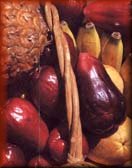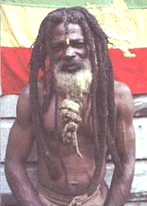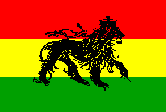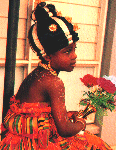What is Rastafari ?
Haille Sellassie & Rasta
Marijuana
Rasta & Reggae
|
The prime basic belief of the Rastafarians is that Haile
Selassie is the living God for the black race. Selassie, whose previous
name was Ras Tafari, was the black Emperor of Ethiopia. According
to Rastafarian philosophy, the scriptures phrophecied him as the one with
"the hair of whose head was like wool (matted hair of a black man), whose
feet were like unto burning brass (black skin)". Rastas believe that Selassie
was the Jesus that Christianity speaks of; that the white man tricked
the world into believing that he was a White man.
Many Rastas do not believe Haile Selassie I is dead. They believed that
it was a trick of the media to try and bring their faith down because
Rastas believe that true Rastas are immortal. To compensate for his death
they believe that his atoms spread through out the world and became part
of new babies, therefore, his life is never ending. The Rastafarian
name for God is Jah.
Ethiopia (Heaven or Zion)
Ethiopia specifically, African in general, is considered the Rastas' heaven
on earth. It is also referred to as Zion. There is no afterlife or hell
as Christianity believes. The Rastas feel that their ancestors did something
to offend Jah which brought them into an exile of slavery in the Western
World such as the Caribbean.
Babylon
Babylon is the Rastafarian term for the white political power structure
that has been holding the black race down for centuries. In the past, the
Rastas see that blacks were held down physicaly by the shackles of slavery.
In the present, Rastas feel that blacks are still held down through poverty,
illiteracy, inequality, and trickery by the white man. The effort of the
Rastas is to try to remind blacks of their heritage and have them stand
up against this Babylon.
Return to Africa
The Rasta's believe that Jah will send the signal and help finance the blacks
exodus back to Ethiopian, their homeland. Any news from Ethiopia was taken
very seriously as a warning to get ready to leave. The belief stems from
Marcus Garvey's theme, "Back to Africa". Although Selassie's death came
before this was possible, it did succeed in turning blacks desire to look
towards Africa as their roots.
Ganja (Marijuana)
Ganja, or better known to non-Rastas as Marijuana, is used for religious
purposes for the Rastafarians. They find its use written in the Bible in
Psalms 104:14, "He causeth the grass for the cattle, and herb for the service
of man". The use of this herb is very extensive among the Rastas not only
for spiritual purposes as in their Nyabingi celebration, but also for medicinal
purposes for colds and such. Other names for it are Iley, callie, and holy
herb. Following are a few of the many Biblical texts that Rastas embrace
as reasons God, or Jah, gave them the use of the herb:
". . . thou shalt eat the herb of the field " (Genesis 3:18)
". . . eat every herb of the land " (Exodus 10:12)
"Better is a dinner of herb where love is, than a stalled ox and hatred
therewith" (Proverbs 15:17)
“He Causeth the Grass to Grow for the Cattle, and Herb for the Service of
Man” (Psalm 104:14)
Food
The true Rasta eats only I-tal food. This is special food never touches
chemicals or is natural and not in cans. This food is cooked, but served
in the rawest form possible; without salts, preservatives, or condiments.
Many Rastas are therefore vegetarians. Those who do eat meant are forbidden
to eat pig because they are the scavengers of the earth. Fish is a staple
I-tal food, however, not crabs, lobster, and shrimp, for these are the scavengers
of the sea. The fish they eat must be small, not more than twelve inches
long. Drinking preferences rest with anything that is herbal, such as tea.
Liquor, milk, coffee, and soft
drinks are viewed as unnatural. The term I-tal is rapidly taking hold in
the consumer industry in Jamaica.
Red, Black and Green
One of the more obvious symbols of the Rastafarians are the colors. These
are red, black, and green. These colors were taken from the Garvey movement.
The color red stands for the Church Triumphant which is the church of the
Rastas. It also symbolises the blood that martyrs have shed in the history
of the Rastas and the black struggle for liberation. The black represents
the color of Africans. Green represents the beauty and vegetation of Ethiopia,
the promised land. Yellow is also sometimes added to represent the wealth
of their homeland.
Dreadlocks
The dreadlocks on a Rastas head also contains symbolism. This symbolizes
the Rastas roots, contrasting the straight, blond look of the white man
and establishment. It not only shows their roots, but it is supported in
the Bible: Leviticus 21:5, "They shall not make baldness upon their head,
neither shall they shave off the corner of their beard, nor make any cuttings
in the flesh". The way the hair grows comes to represent the symbol of the
Lion of Judah (explained further down). This has also come to symbolize
priesthood and naturality.
Lion of Judah
The Lion of Judah represents Haile Selassie, the Conqueror. It represents
the King of Kings as a lion is the king of all beasts. Others believe that
it represents the male majority of the movement. Selassie wore a Lion of
Judah ring that was given to Bob Marley at the time of Selassie's death.
The where-abouts of the ring is unknown because it disappeared after Marley's
death.
I and I
The expression "I and I" is frequently heard among Rasta talk. What it means
is that no person is priviledged than another in the basic truth of life.
All people are totally equal. This is why many times Rastas will opt to
use "I and I" instead of "you and I" because they believe that all people
are bound together by the one god, Jah.
|






